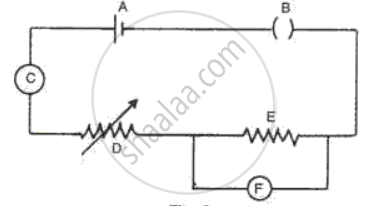Advertisements
Advertisements
Question
Solution
According to Ohm's law, the current flowing in a conductor is directly proportional to the potential difference across its ends provided the physical conditions and temperature of conductor remains constant.
No, it is not always true. E.g. Diode valve, junction diode etc. do not obey Ohm's law.
APPEARS IN
RELATED QUESTIONS
Find the resistance of a conductor if 0.24 A current is passing through it and a potential difference of 24 V is applied across it.
Write the formula of resistivity
State Ohm’s law and draw a neat labelled circuit diagram containing a battery, a key, a voltmeter, an ammeter, a rheostat and an unknown resistance to verify it.
Fig. represents the circuit used for the verification of Ohm's law. Label the parts from A to F. state the function of each.

Which of the following I-V graph represents ohmic conductors?
The unit of specific resistance is ____________.

Calculate the total resistance of the circuit and find the total current in the circuit.
A metal rod of length 10 cm and a rectangular cross-section of 1 cm × `1/2` cm is connected to a battery across opposite faces. The resistance will be ______.
What is the resistance of a conductor through which a current of 0.5 A flows when a potential difference of 2V is applied across its ends?
A current of 0.8 A flows in a conductor of 40 Ω for 1 minute. The heat produced in the conductor will be ______.
